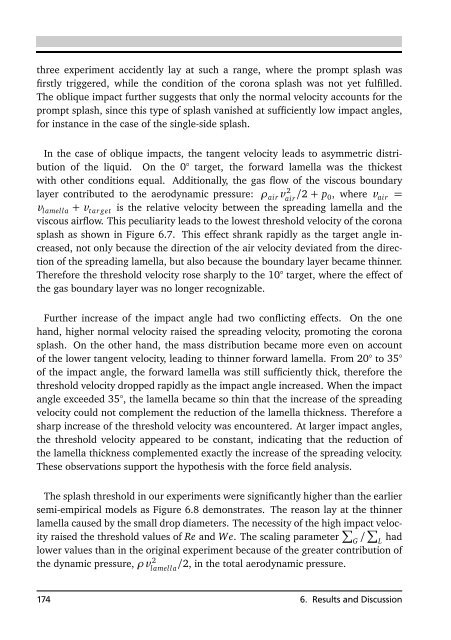front page - tuprints - Technische Universität Darmstadt
front page - tuprints - Technische Universität Darmstadt
front page - tuprints - Technische Universität Darmstadt
You also want an ePaper? Increase the reach of your titles
YUMPU automatically turns print PDFs into web optimized ePapers that Google loves.
three experiment accidently lay at such a range, where the prompt splash was<br />
firstly triggered, while the condition of the corona splash was not yet fulfilled.<br />
The oblique impact further suggests that only the normal velocity accounts for the<br />
prompt splash, since this type of splash vanished at sufficiently low impact angles,<br />
for instance in the case of the single-side splash.<br />
In the case of oblique impacts, the tangent velocity leads to asymmetric distribution<br />
of the liquid. On the 0° target, the forward lamella was the thickest<br />
with other conditions equal. Additionally, the gas flow of the viscous boundary<br />
layer contributed to the aerodynamic pressure: ρ air v 2 air /2 + p 0, where v air =<br />
v lamella + v tar get is the relative velocity between the spreading lamella and the<br />
viscous airflow. This peculiarity leads to the lowest threshold velocity of the corona<br />
splash as shown in Figure 6.7. This effect shrank rapidly as the target angle increased,<br />
not only because the direction of the air velocity deviated from the direction<br />
of the spreading lamella, but also because the boundary layer became thinner.<br />
Therefore the threshold velocity rose sharply to the 10° target, where the effect of<br />
the gas boundary layer was no longer recognizable.<br />
Further increase of the impact angle had two conflicting effects. On the one<br />
hand, higher normal velocity raised the spreading velocity, promoting the corona<br />
splash. On the other hand, the mass distribution became more even on account<br />
of the lower tangent velocity, leading to thinner forward lamella. From 20° to 35°<br />
of the impact angle, the forward lamella was still sufficiently thick, therefore the<br />
threshold velocity dropped rapidly as the impact angle increased. When the impact<br />
angle exceeded 35°, the lamella became so thin that the increase of the spreading<br />
velocity could not complement the reduction of the lamella thickness. Therefore a<br />
sharp increase of the threshold velocity was encountered. At larger impact angles,<br />
the threshold velocity appeared to be constant, indicating that the reduction of<br />
the lamella thickness complemented exactly the increase of the spreading velocity.<br />
These observations support the hypothesis with the force field analysis.<br />
The splash threshold in our experiments were significantly higher than the earlier<br />
semi-empirical models as Figure 6.8 demonstrates. The reason lay at the thinner<br />
lamella caused by the small drop diameters. The necessity of the high impact velocity<br />
raised the threshold values of Re and We. The scaling parameter ∑ G / ∑ L had<br />
lower values than in the original experiment because of the greater contribution of<br />
the dynamic pressure, ρv 2<br />
lamella<br />
/2, in the total aerodynamic pressure.<br />
174 6. Results and Discussion
















